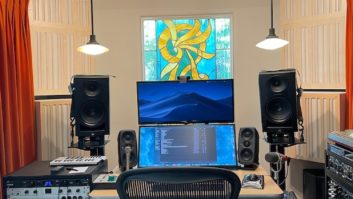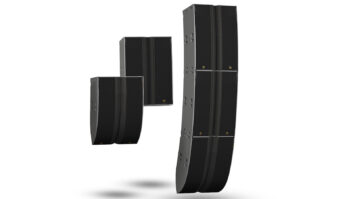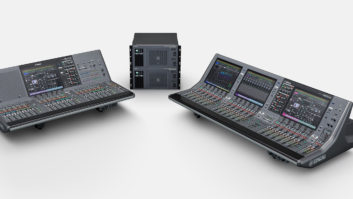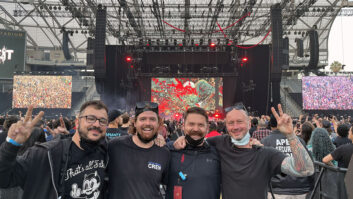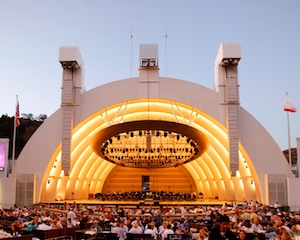
The Hollywood Bowl, that iconic Los Angeles venue so named for the landscape it occupies, not the shell covering its stage, hosted its first classical music concerts in 1922. At the time of its opening, the venue’s natural acoustics were considered perfect as is. The trademark shell, with concentric staggered rings of reflective material, first appeared in 1928 to help boost the natural sound. Amplification arrived eight years later, with a system driven by 500-watt amplifiers from Bell Laboratories, according to The Los Angeles Times.
A variety of systems have been in place over the years, determined and defined largely by an ever-growing variety of music genres. Famed promoter Bob Eubanks noted that the contract rider for his first presentation of The Beatles at the Bowl in 1964 required only “an adequate sound system.” Their arrival, along with the many rock acts that followed, immediately rendered whatever was considered adequate at the time no longer so.
While the physical Bowl was renovated in 2003, including replacement of its shell structure with one 30 percent larger, the sound system was given a full makeover a decade later, just prior to the 2013 season, in what its hosts consider the ultimate supplement to what nature originally provided.
On an afternoon’s visit, while the Los Angeles Philharmonic rehearses, principal sound designer Fred Vogler, who has been mixing at the Bowl for 12 years, briefly mutes the audio system from his front-of-house position two-fifths of the way up from the stage. “When we turn off the P.A., you get a sense that there’s an ensemble playing, but you don’t get a sense of the delicacies and all of the intricate melodies and harmonies that are important to the experience,” he says. “Our objective is to make the orchestral experience as acoustic and natural-sounding as possible. And by doing so, we can make the sound bigger, broader and fuller.”
The venue still, of course, hosts classical, pops and rock shows—even combinations thereof, such as a recent show featuring Elvis Costello and the L.A. Phil. But it is the classical audience for whom even the slightest detail must be reproduced accurately. “They’re a discerning audience,” Vogler notes. “They are accustomed to a certain sound quality at the concert hall and on recordings. They expect the violins to sound like violins, and the woodwinds to have a certain presence and color to them. If the timbre or positioning isn’t right, these people notice.”
The 2004 sound system upgrade, designed in part by the Bowl’s monitor engineer and systems engineer, Kevin Wapner, was complete, replacing everything from the mixing console and loudspeakers to infrastructure and wiring. Wiring runs from both the stage to the amp room, as well as to the mixing position, were replaced or upgraded, and cable lengths were shortened to reduce impedance. “Reducing the lengths made a huge difference,” Vogler says. “Plus, it’s an outdoor venue, and some of the lines were 10 or 20 years old. Because of the environmental factors, they are not as reliable after more than 5 or 10 years.”
At FOH, the team replaced its Yamaha PM1D digital mixer with a DiGiCo SD7, connected throughout the venue via a Group One Ltd. Opticore LX4 Optical Digital Multicore Network System. “We wanted something that was quick and that had high resolution, with up to 96k in and out,” Vogler says. “We can readily arrange the elements with the assignable control surface and cater the surface to whatever the show’s needs are, whether it’s pops or rock.”
A recent performance by Marcus Miller contained elements of pop, along with a jazz element toward the front of the stage and orchestral in the rear. “With plenty of soloists coming and going, it was nice to be able to move stuff around, as needed, without hunting and moving around the console too much,” Vogler says. “That type of board is invaluable for this kind of setup.”
The venue’s loudspeaker array comprises L-Acoustics components, the company working alongside the Bowl team to create a cohesive system. The main left-right arrays feature 16 K1 enclosures per side, with four K1-SB extensions and four KARA units below those.
“One of the big advantages of the K1 system is that they’re so prevalent as a touring rig,” notes Michael Sheppard, the Bowl’s head of audio. “Large tours come in here and see them and go, ‘Oh, you’ve got a K1. I can just send mine on to the next venue.’ They don’t have to unload theirs; plus, they’re familiar with the K1 and know how it performs. So they already have a good handle on how their mix is going to be that night.”
The center fills are made up of eight KARAs, which also feature in one of two front-fill options the Bowl utilizes. “We’ll have those for our louder shows, ones that require a little more amplification across the front,” Vogler explains. “And then for a quiet show, such as an orchestral concert, we’ll use L-Acoustics 5XTs. They have a low profile, but they give enough fidelity for the people sitting closest to the stage, and still allow them to see over them.”
The subwoofers, on either side, are sets of eight L-Acoustics SB28s, with four ARCS WIDE, which bring the powerful response. “When we do a real thumpin’ show,” Vogler says, “you definitely feel your body and the fabric on your body moving around.”
For those seating sections far wide of the stage that don’t provide direct line of sight to the main array, a set of 12XTs hang above to offer enhancement. In addition, eight small JBL speakers allow Vogler to provide reverb or other effects as needed, for surrounds. “They just give it a sense of size or space around the edge, and are really only heard in the box section of seating,” he says.
There are no delay speakers spaced further in the seating,” Sheppard says. “From side to side, there is very, very little difference in the quality and volume of the sound. And then, from front to back, over 450 feet, I doubt you hear anything more than about 5- or 6dB difference. It’s pretty remarkable, the physics of how this line array works. We’re very stereophonic here in our mixing—we don’t mix mono. We want it to have a breadth and a depth. There’s some pushback—we have some mixers that come through that believe more that everybody should hear equal. But we’ve found that this gives orchestral sound a real life and dimensionality.”
The Bowl’s shell does provide some reflection, though not through the full frequency range. While both the conical-shaped ribs and the canopy above the orchestra do tend to focus sound outwards, frequencies below about 500 Hz tend to drop off, Vogler says, taking that into consideration when choosing and positioning mics.
The team draws from a large collection of studio condenser-type microphones for just about everything, including Sennheiser, Schoeps and Neumann. Mics used for a particular orchestral section on one day might not be the best fit on another, depending on the configuration of the stage. Typical orchestral miking can involve as few as 30 to 40 microphones. A pair of Sennheiser MKH 800 Twins hanging overhead act as the mains, providing a significant amount of the sound. “They have a front and back capsule, with dual outputs. So I can change the polar pattern by adjusting the level of one or the other output, depending on what’s needed,” Vogler explains. Over the center of the orchestra are three Schoeps MK21s, suspended just 10 feet above the players.
Onstage, the principal strings are miked with MK4s, Colette mics in cardioid, while the celli and bass use Sennheiser MKH40s. The brass instruments are picked up by Neumann U89s, and the woodwinds by TLM 170s, both set in a wide cardioid pattern.
Rock acts typically bring their own mic collection, also using about 30 or 40 mics/inputs, as well as their own preferred console, which is typically set up in a guest mix position. The guest console’s output is then fed to the Bowl’s FOH SD7, which sends it out flat to the amplifiers and speaker system. “They’ll give us a left-right and a sub send,” says Sheppard. “They may also give me a send for the front fill or the center cluster. That gives some flexibility to what kind of sound they put out. But they paint the sound the way they want to hear it, so that it’s the artist’s sound, not our sound.”
Says Sheppard, “In a week’s time, we often do a rock ’n’ roll show on Monday, and then on Tuesday we’ll do a classical show. And then on Wednesday, it’s a jazz show, and then Thursday another classical show, and Friday/Saturday a pop show, and a World Music Festival on Sunday. It’s not unusual for us to be out of here at midnight and then be back at 8 a.m. to begin setting up for the next concert.
“When we were consulting with everyone over this P.A. and our consoles, that was something that we had to take into account, being able to shorten or eliminate any turnaround time, as far as repositioning or retuning the P.A.,” Sheppard adds. “It has the versatility to allow us to do a rock show one night and a classical music show the next, with very little in the way of adjustment, and still be able to achieve the same degree of fidelity throughout the venue.”
Audiences have clearly responded. “I’ve seen more standing ovations, more people sitting forward in their chairs and engaged in the show,” Vogler notes. “The dynamics are really extended with this higher resolution system. When it’s quiet, the audience is incredibly quiet and really paying attention. They’re watching the performers in a way that I don’t think I’d seen in prior seasons. People will come up to me after a show and tell me, ‘I’m hearing things that I never heard before.’ It’s been a 10-year effort to make this P.A. what it is. It’s now tuned to the point where we can really provide everybody in the house a good seat.”

